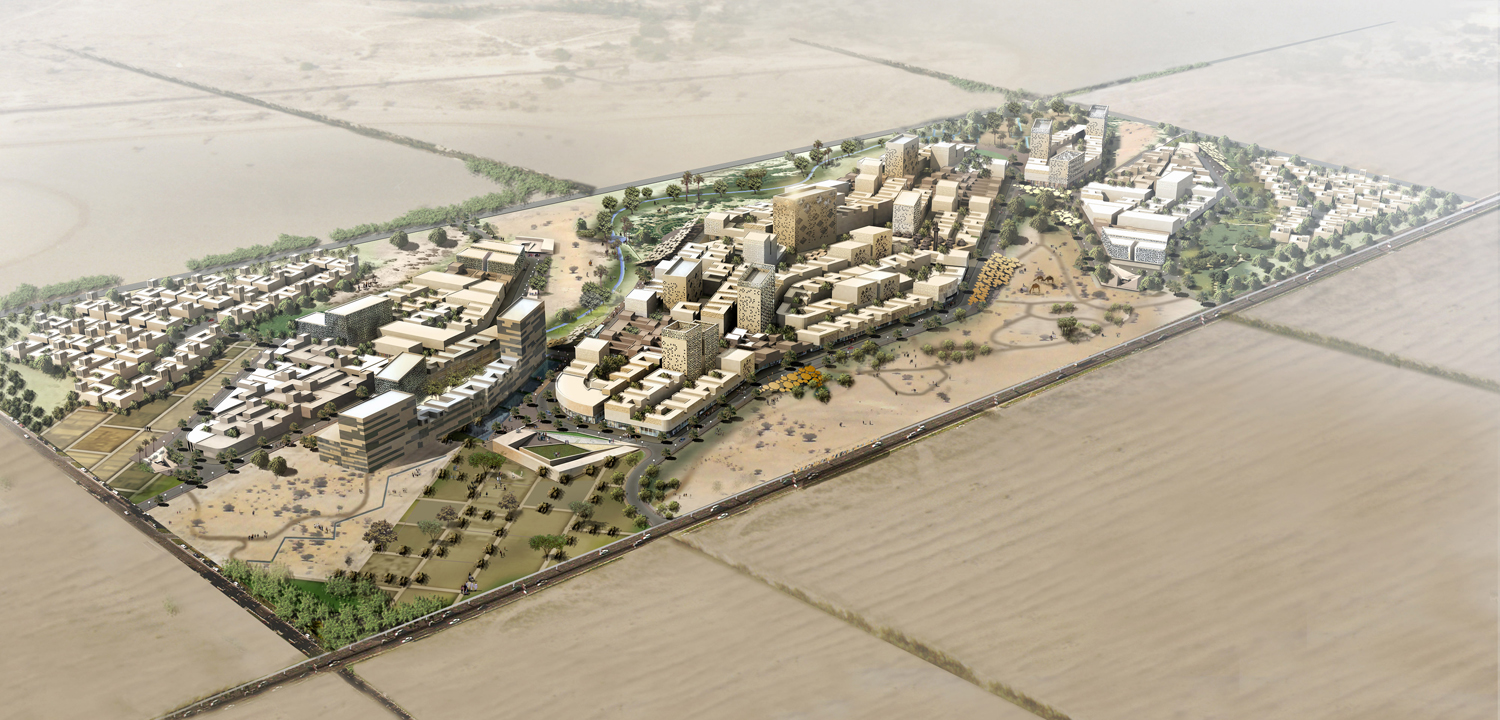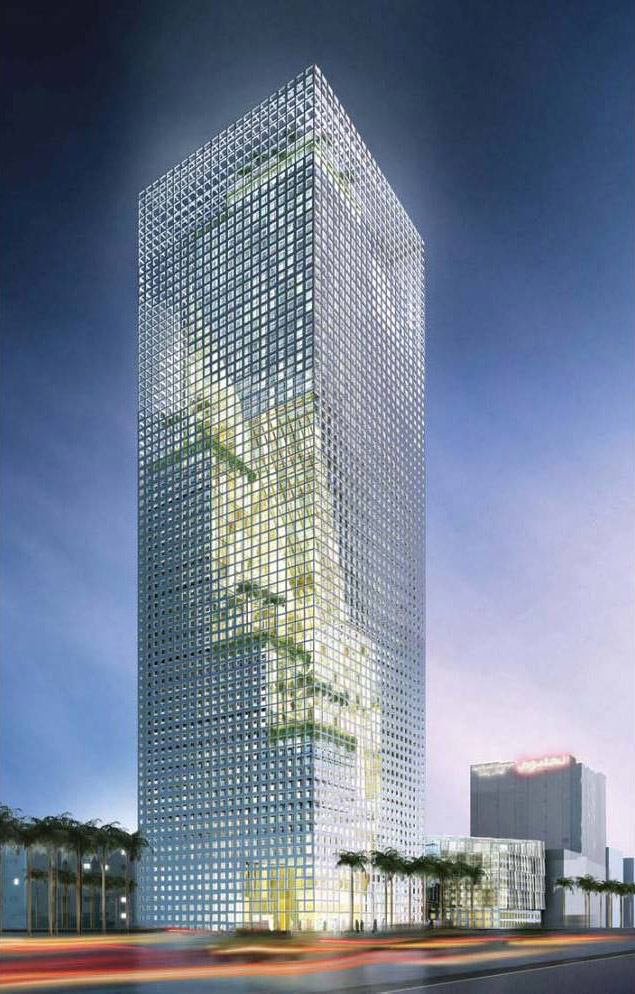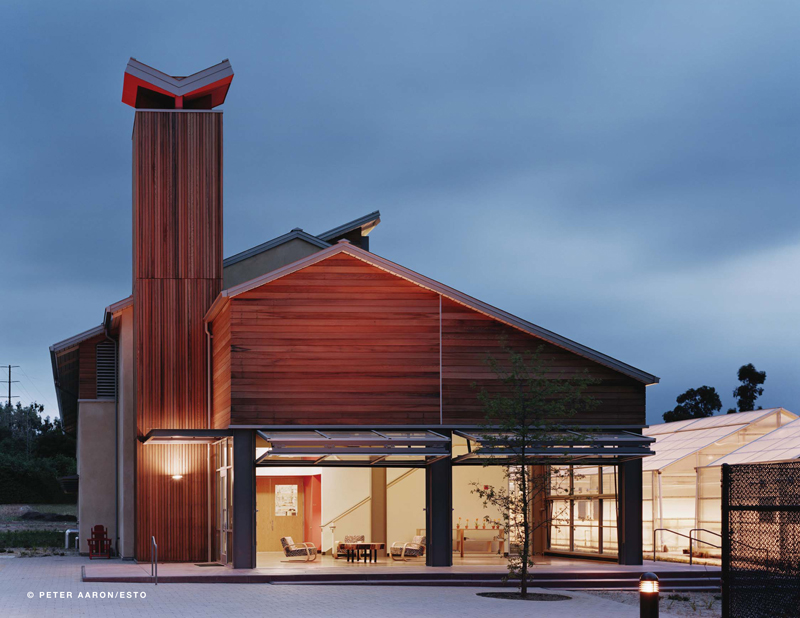|
|
Karim Elgendy
Throughout the last three decades, the city of Dubai has not been known for its emphasis on sustainability as guiding principles for its development. Not only did it adopt an unnatural rate of growth by middle eastern and global standards, it has also long disregarded the environmental and social consequences of its rapid urbanization. Dubai’s growth relied on -and was economically fueled by- a development model which imported inappropriate and inefficient building forms and planted them in its extreme climate. The result was a 1,500 square miles city (3,885 square kilometers) with isolated island buildings that are not only divorced from their environments, but which also require a great amount of fossil fuel energy to remain habitable.
 Image 1. Aerial View of Xeritown showing massing and landscaping. Copyrights: X-Architects and SMAQ The city of Dubai also has one of the highest carbon footprints per capita in the world, and even though this footprint is partially a result of energy intensive water desalination processes on which the city relies for its potable water, Dubai’s carbon footprint remains higher than that of other gulf cities including Saudi cities which also rely greatly on desalination.
In many ways, it is fair to argue that the Dubai’s model of development has been, in essence, the antithesis of sustainable development over the last three decades. In other words, Dubai has come to represent the climax of an obsolete development model in which humans attempted to subjugate their environment rather than coexist with it.
In contrast to this un-sustainable development pattern, Dubai’s neighboring city of Abu Dhabi has long adopted a measured and less extravagant development model. Over the same three decades, Abu Dhabi’s development model was generally characterized with a more sustainable pace of development. In the last few years, Abu Dhabi has been attempting to champion sustainable development in the Middle East by establishing a sustainability oriented framework for its development over the next 20 years, and by establishing the Masdar initiative which includes the world’s most progressive sustainable city project at its outskirts with ambitious zero-energy and zero-waste targets.
Continue reading Dubai Experiments with Sustainable Development
Karim Elgendy
UPDATED – The King Abdullah University of Science and Technology (KAUST) at Thuwal (near Jeddah) in Saudi Arabia was recently announced as one of the winners of the American Institute of Architects’ Top 10 Green Buildings awards for 2010.
The new international graduate-level research university was established by the government-owned Aramco, the world’s largest energy corporation, to drive innovation in science and technology and to support world-class research in areas such as energy and the environment. The campus project was designed by HOK Architects and was completed in September 2009.
KAUST’s new campus is Saudi Arabia’s first LEED certified project earning a Platinum certification, the highest rating in the United States’ green building rating system At 496,000 Square meters, the project also represents the world’s largest LEED Platinum project.
 Image 1. Night view. Copyrights J. Picoulet and HOK Continue reading KAUST: A Sustainable Campus in Saudi Arabia

Karim Elgendy
UPDATED – In April 2010 the Estidama program of the Abu Dhabi Urban Planning Council partially released the first version of its rating system suite, The Pearls Rating System for Estidama. The release included the design and construction portions of the the rating system suite which includes rating systems for buildings, villas, and neighborhoods.
Prior to its release Estidama has occasionally referred to the upcoming system as one that learns from its established predecessors, the British BREEAM rating system and the American LEED rating system (BREEAM stands for British Research Establishment Environmental Assessment Method, and LEED stands for Leadership in Energy and Environmental Design). The decision to learn from these rating systems was not only to learn from their mistakes but also to help create a system whose requirements are familiar to the market. On the other hand, the Estidama program asserted that the Pearls Rating System would not be a direct copy of either systems given the environmental and cultural differences of the Emirates
Given the debates that exist amongst practitioners and researchers on both sides of the Atlantic on the merits, shortcomings, and differences between BREEAM and LEED. An analysis of Estidama’s Pearls Rating System in comparison to these two established rating systems was necessary. The first version of the Pearls Rating System for Estidama will be compared to the latest version of the LEED rating system, LEED 3.0 (also known as LEED 2009), and the latest update of the BREEAM rating system, BREEAM 2008.
Continue reading Comparing Estidama’s Pearls Rating System to LEED and BREEAM
 Image 1. A night view of the design showing the shading envelope and the spiraling forms behind. Copyrights: Perkins+Will In February 2010, the design for Al-Birr Foundation Headquarters in Riyadh, Saudi Arabia, has been named as the winner of the 2010 Architectural Review / MIPIM Future Projects Awards under the ‘tall buildings’ category (Image 1). The unbuilt project, designed by Perkins+Will’s New York Office, was commissioned for Al-Birr Foundation, a non-profit organization aimed at alleviating poverty and caring for disadvantaged families and children.
The Design
Of the many features of the design of the 59, 000 sqm tower, perhaps the most interesting is how it was concieved as a sustainable urban tower that responds to the environmental characteristics and the microclimate of the city of Riyadh, which is a challenging climate to address given the extreme solar exposure and the heat conditions of Riyadh.
Faced with these climatic conditions and a deep plot of 1000 x 1200m, the projects’s designers response was to rethink the high rise typology in this context. The design’s most visible response to the climate is the building’s envelope which was designed as a large rectangular frame of brise-soleil enclosing the occupied parts of the building. This shading frame was designed to respond to both the different amounts of solar radiation received by each elevation as well as the interior spaces behind it. To achieve this result, a mapped shading mesh was devised to provide varying levels of openness for different locations of the different elevations depending on its solar exposure and its spatial/contextual influences. The result was an envelope that resembles a mesh of varying densities surrounding the building and simultaneously protecting and revealing the activities behind it.
This proposed design solution thus helps the building reduce its solar heat gain while maintaining its views towards the city (FIgure 1). In addition to this shading effect, the mesh-like dynamic treatment of the envelope has also helped animate the building’s expression with the dense and sparse zones of the facade adding a dynamic effect to what otherwise may have become a static pure form.
Continue reading Riyadh Tower Design adapts a Traditional Middle Eastern Shading Strategy
Karim Elgendy
The Carnegie Center for Global Ecology in Stanford is a research facility that combines Laboratories and office spaces. The 1100 Sqm building was built on a previously developed plot of 7.4 acres. The client’s main concerns were lowering the carbon emissions tied to the building’s energy use as well as the embodied carbon emissions of building materials. Flexibility over the short and long term was also of utmost importance to the client who wanted to allow for the expansion and contraction of research teams.Like Many of the Climates of the Middle East, Stanford has an arid climate with a long dry summer season, and benefits from northwest breezes.
 Image 1. View of the Eastern facade of the Carnegie Center showing the wind tower and the naturally ventilated entrance lobby. Copyright: Peter Aaron / Esto
Karim Elgendy
A pan-Arab survey conducted by the Arab Forum for Environment and Development (AFED) found that a resounding majority of 98% believed that the climate is changing.
The survey sample which included a big segment of educated people (who more reflect the views of those nearer to decision making, than proportionally reflect the actual population mix) showed that only a small portion of 5% said they did not understand what climate change was, reaching a maximum of 11% in Syria. However, 95% of those who said they did not understand what climate change was, still answered that they believed the weather was changing, (Figure 1). A majority of 89% also thought that this change was due to human activities, including excessive use of energy and depletion of resources, (Figure 2). These results clearly showed that climate change has become widely accepted by the public in Arab countries as a fact which needs to be addressed. Moreover, the survey showed that the skeptical attitudes which prevailed among some groups on the facts and causes of climate change, either denying it entirely or limiting it to natural causes, are decreasing.
 Survey Figure 1. Source: AFED Arab Environment Climate Change Report. Continue reading The Arab World’s Opinion on Climate Change
Karim Elgendy
In recent years much of the discussion about the impact of climate change around the world has caused a mix of anxiety and fear about the impacts this may have on human life and the environment. Many detailed studies have shown by using simulation models the impact of sea level rises on coastal cities around the world if sea level were to rise by a certain degree. These studies showed that generally speaking, it was low lying areas and river deltas that were most vulnerable, especially when these deltas are densely populated.
 Figure 1. Relative vulnerability of coastal deltas as shown by the indicative population potentially displaced by current sea-level trends to 2050 (Extreme = > 1 million; High = 1 million to 50,000; Medium = 50,000 to 5,000 (following Ericson et al.,2006). Source Nicholls, R.J., P.P. Wong, V.R. Burkett, J.O. Codignotto, J.E. Hay, R.F. McLean, S. Ragoonaden and C.D. Woodroffe, 2007 Continue reading The Impact of Sea Level Rise on The Arab World
|
|







